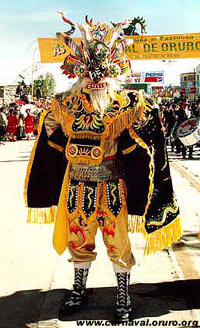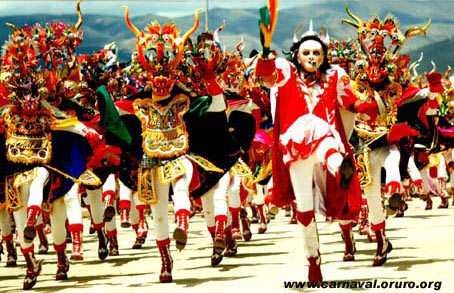Carnival in Oruro

The carnival takes place in February. Its origin dates back to distant past and connected with appearance of the Holy Virgin, patroness of the Bolivian miners in an abandoned mine. The participants of the carnival grant honours to Virgen de Socavon. However, the carnival in Oruro is not that religious festival as it is a public one. Complete Bolivia takes part in it. Every enterprise, every educational establishment “nominates a team” to a fascinating dancing march-show.
No spectator remains indifferent to the rhythms, bright dresses and masks of such dances as Diablada, Caporales, Morenada. Every dance has its meaning. So, Diablada, - devil's dance, - is an eternal fight of good and evil. By the way, Diablada is also the oldest carnival dance, its birth dates back to 1789. Caporales takes us to the times, when black slaves were brought to Bolivia to work at gold and silver mines, and cruel slave-drivers - capataz – had not spared them. Black slaves could not stand high mountains and died. And the dance about slave drivers remained! Morenada is the dance of dusk girls – is the most tender performance of the carnival. There is a lot of humor in a “tax collector” dance, here the folk fantasy has no boundaries!

Not all – even in Bolivia – can get to the carnival in Oruro. That is why parallel carnivals, maybe not that luxurious as in Oruro but not less festive, are arranged in other cities. For example in La Paz, such a carnival is held by university students and school children. So February in Bolivia is full of music and dances!